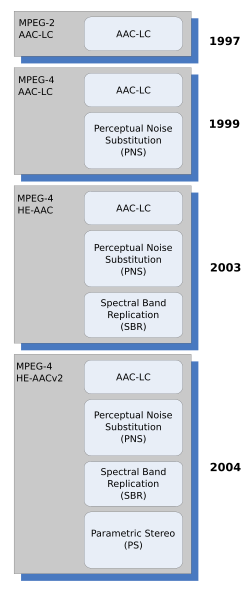Mpeg-4 Aac Lc Codec Virtualdub
HE-AAC is simply LC-AAC with SBR. The format of the resulting AAC stream is no different. Actually SBR can be applied to MP3 just as well (known as 'MP3pro'). SBR is pre-processing before the actual AAC encoding step.
Added experimental recognition of the following Audio Codec IDs: 'A_AAC/MPEG2/MAIN' 'A_AAC/MPEG2/LC' 'A_AAC/MPEG2/LC/SBR' 'A_AAC/MPEG2/SSR' 'A_AAC/MPEG4/MAIN' 'A_AAC/MPEG4/LTP' 'A_AAC/MPEG4/SSR' Note that I have not tested any of these! Added an Extended Open option to force the 'H264'. Support to decode MPEG-4 AAC is provided by gstreamer1.0-libav and to decode H.264 there is gstreamr0.10-ffmpeg: $ sudo apt-get install gstreamer1.0-libav gstreamer0.10-ffmpeg For more information have a look at the Ubuntu Documentation. MPEG-4 AAC LC Audio Codec? Discussion in 'Sound Cards and Speakers' started by Dwarfer, Mar 22, 2007. Dwarfer Guest. Hi, according to Divx GSpot, a movie file I have needs the MPEG-4 AAC LC Audio Codec, I've looked all over the net and canny seem to find it anywhere for download.
And indeed it will divide the the sampling rate by 2 (and thus 'remove' the higher frequencies according to Nyquist Theorem). As a result, you will get only 1/2 sampling rate (and thus worse quality) compared to the original, when using an AAC decoder that does not support HE-AAC (SBR).
When using an HE-AAC-capable decoder, the output will be upsampled to the original sample rate and the 'missing' frequencies will be synthesized. Still that is a property of the AAC format and is not related to AVI at all. Audio streams with varying sample size work just fine with AVI - if done in the right way.
Only some buggy AVI splitters don't handle it properly, because they make the (false) assumption that audio streams will always use fixed-size samples. Whether the AAC decoder, which will be used to decompress the AAC data later, does support HE-AAC (SBR) or not, that is a completely different and AVI-unrelated question. See also: (Have a look at 'MP3-VBR-in-AVI is a dirty hack' and 'AAC in AVI does not work'). 1) Long answer: the explanation was already posted on the VirtualDub forums ( but I'm too lazy to look for it right now ). Grosso modo, and just as an example, the ACM decoder plays at 24kHz something that was encoded at 48kHz. 2) Short answer: just try and hear 3) Not an answer: 'AVI sucks' 1) That's why I was asking. Because technically it is NOT encoded at 48kHz.
Virtualdub Compression Codec
Sampling rate is artificially doubled on decoding. 2) Are you saying that I should find and install some crappy decoder/splitter combination that will fail like that just to satisfy my curiosity? No thanks ツ 3) Agree. Quote: Originally posted by I have no control over the sample rate in an AVI file. If the AVI audio header declares that the sample rate is 22050 Hz (as this one does), then that is indeed what you will hear. This heavily depends on the context.
Maybe it applies to the VFW interface. But VFW is only one (out of many) specific software implementation to read AVI files.
VFW is outdated/discontinued, as we all know. At the same time AVI is only a container format.

Hence it only specifies the the file format, but it does not specify how the software that reads the file has to behave. For HE-AAC it makes sense to specify the 'base' (not re-upconverted) sample-rate as the stream's sample-rate in the AVI header. That is exactly the sample rate that a Non-HE-capable AAC decoder would return. Software that does supports HE-AAC must be aware that the final decoded + post-processed output sample-rate may be different from the 'base' rate. And it obviously must be able to deal with that fact. Consequently you must not blame the container format (i.e.
Specification), when the actual problem lies in one specific broken/outdated/incomplete software implementation of that format. Avidemux does not use VFW, because it's outdated and platform-specific.
Also the claim that VFW is 'very high quality' doesn't make any sense. VFW is just the interface between the application (e.g. VirtualDub) and the individual VFW Codec (e.g. The quality depends on the Codec that you use. Avidemux has two lossless encoders (FFV1 and HuffYUV) built-in, which is the best possible quality you can get - 100% lossless. Moreover Avidemux comes with x264 as well as Xvid built-in. What other encoder do you need?
Last but not least: You must not resize interlaced video. You will have to deinterlace (in Bob mode!), then apply the resize filter and finally re-weave. (The 'interlaced' checkbox in VirtualDub's resize dialog probably is nothing but a shortcut for this procedure).